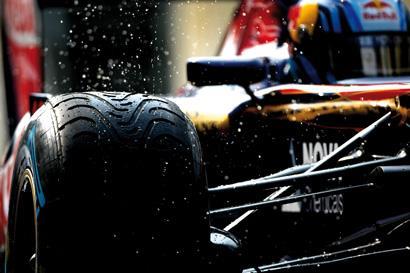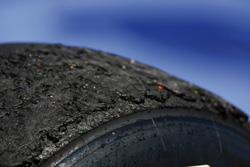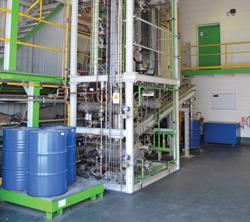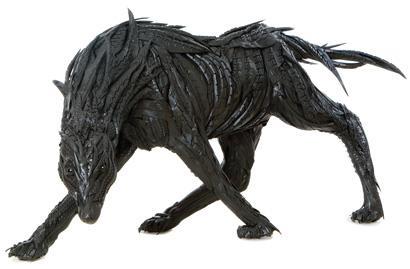A tyre's composition affects grip, fuel economy and its lifetime. Fiona Case investigates how new materials are improving tyre performance and reducing environmental impact
A tyre’s composition affects grip, fuel economy and its lifetime. Fiona Case investigates how new materials are improving tyre performance and reducing environmental impact
Tyres have had an image problem. They were the scourge of landfills: dumped in developing countries or burning for years on waste heaps like the one at Heyope in Wales, releasing noxious fumes. But this image is changing thanks to new materials and legislation that will ensure their adoption. The environmental villains are going to provide significant improvements in vehicle fuel consumption and safety, they are no longer going to landfill (although we don’t yet have an ideal end-of-life scenario), and they may even be made from sustainable, not fossil, raw materials.
Modern tyre rubber is a crosslinked polymer matrix which typically contains only 10 per cent natural rubber (cis -1,4-polyisoprene). A range of polymers including natural and synthetic polyisoprene, poly(styrene-butadiene), polybutadiene and poly(isoprene-isobutylene) are blended with reinforcing fillers (carbon black or silica), sulfur (the crosslinking agent), antioxidants and processing oils.

’Tyres are very highly engineered composites. There are more than 18 different components and over 12 different rubber formulations in a passenger tyre, for different parts such as the tread, the sidewall, the undertread; in addition to steel, polyester and nylon,’ says David Zanzig, director of global materials science for tyre manufacturer Goodyear. ’How we put the items together determines performance.’
The performance triangle
’In a passenger tyre tread we are attempting to increase traction or grip, reduce tread wear and also reduce rolling resistance - which is the energy dissipated as heat as the tyre deforms in contact with the road,’ explains Zanzig. These attributes are typically in opposition and define a performance triangle. ’For example, for good grip you want a high coefficient of friction between the tyre and the road,’ he comments. ’You want the opposite to reduce rolling resistance and improve fuel consumption. We are working to reduce the impact of rolling resistance while maintaining other tyre performance through lightweight constructions, tread design, innovative materials and new manufacturing processes.’
New legislation is accelerating development. All tyres on sale in the EU from November 2012 will be labelled to show rolling resistance (influence on fuel consumption), wet grip and rolling noise. Mandatory reductions in rolling resistance will be introduced at the same time, with further reductions in 2016. Tyres will also have to be quieter, with new standards from 2012 and entire market implementation expected by 2016.
’A huge majority of tyres currently sold in Europe do not meet the 2016 criteria,’ says Thomas Gross, head of global technical marketing and product development for synthetic rubber specialists Lanxess. Researchers at Lanxess have been developing new solution-polymerised poly(styrene-butadiene) rubbers (SSBR) and polybutadiene rubbers (PBRs) to widen the area of the performance triangle. ’Using anionic living polymerisation we can manipulate the SSBR polymer microstructure, and the grip or traction of the tyre, by varying vinyl and styrene content,’ says Gross. ’Increasing the vinyl content increases miscibility with polyisoprene or polybutadiene rubbers and reduces the glass transition temperature of the composite. It’s only a few degrees, but it makes all the difference for winter tyres which need to be soft to grip the road at lower temperatures.’
Killer filler

The reinforcing filler, which can be more than 40 per cent of the tyre rubber, plays a key role in the elastic efficiency (and the rolling resistance). ’If the filler is not well dispersed, inelastic filler-filler interactions are significant. The energy required to disrupt those interactions as the tyre changes shape, when it rolls or indents on the rough road surface, is lost,’ explains Gross. ’If you disperse the filler more effectively and improve the polymer-filler interactions, you improve the elastic behaviour of the material and the rolling resistance of the tyre.’
In 1992 Michelin introduced their ’green tyre technology’ using silica filler plus a bifunctional silane, bis-(triethoxysilylpropyl)tetrasulfide, rather than the traditional carbon black. ’Within the mixer the silanes react with the silica surface via their alkoxy groups and help disperse the filler. When the material is vulcanised the sulfur creates a link between the silica and the polymer. Using SSBR-silica-silane materials results in 20-25 per cent reduction in rolling resistance,’ says Gross. Michelin estimates that its tyres have saved more than 14.4 billion litres of fuel, corresponding to 36 million tonnes of CO2 emissions, since they were launched.
You can modify the polymers to improve on original the green tyre technology. ’We have developed SSBRs which have pendent COOH-groups statistically distributed along the entire polymer main chain. This enhances adhesion with the silica after vulcanisation, but also during mixing. It improves rolling resistance characteristics and fuel efficiency, and also the wet braking performance,’ says Gross. ’Because of the traction improvements, one customer is testing it for racing tyres.’

Goodyear recently introduced silica filled tread formulations incorporating polymers that were engineered to interact directly with the filler, in addition to the silane coupling agents. They claim the innovations they have introduced since 2005 have improved rolling resistance by 30 per cent, saving 9.5 billion litres of fuel.
So why aren’t all tyres made using these materials? ’You need more efficient and sophisticated mixing equipment,’ says Gross. ’When you’re using carbon black you just mix, with the silica-silane filler you also have a reaction taking place in the mixer which you need to control. This has led to resistance from some tyre manufactures. We are working to modify our polymers to allow easier mixing,’ he says.
Extreme performance
The fact that silica filled tyre rubbers also provide good road grip is particularly important to Pierluigi de Cancellis, director of materials development for Pirelli, which creates tyres for Formula 1 racing. ’The performance triangle does not apply to F1 tyres,’ says de Cancellis. ’Rolling resistance is not key to performance: there are other factors that have more impact on drag. The tyres, particularly those designed for wet conditions, are not intended to last a long time: it makes the race more lively if teams are forced to make pit stops. Wet traction and road grip are the most important characteristics.’ The six types of tyre rubber used for F1, identified by different colours, have distinctly different properties. ’F1 slicks go from red (supersoft), which delivers maximum grip with reduced wear life, to silver (hard), which provides maximum durability with lower performance,’ explains de Cancellis. ’The wet (orange) tyres need to be soft and easy to deform at lower temperatures to get better indentation on the tarmac and give good grip. The more hydrophilic silica filler reduces the chemical incompatibility between the tyre and water. It also alters the temperature dependency of rubber deformation, helping the rubber to stay soft at lower temperatures and at higher frequencies,’ he says.
The way that tyres grip the road is difficult to measure directly in the laboratory. ’When we want to predict the performance of new compounds, we measure the viscoelastic properties under a wide range of conditions - temperature, frequency, different types of stress, to cover the range of conditions found in service,’ says de Cancellis. ’The data is fed into a predictive model which we have developed and validated using test data from the race track. We can predict performance and durability under specific conditions: tarmac temperature, speed, vehicle mass,’ he says. ’It is quite accurate.’
’This is a benefit for Pirelli of being involved with F1,’ he says. ’F1 is the most pure and extreme expression of performance, and glamour, for tyre materials. It also provides the opportunity to test new materials under the most extreme conditions, working with the most professional car engineers in the world. We can develop and test exotic new materials, which helps to develop and validate our models. And we can transplant this knowledge of road holding into the design of everyday tyres.’
Gaining traction
The early history of tyre rubber centres around names still associated with the business. In 1839, Charles Goodyear was experimenting with sticky natural rubber, and accidently dropped a ball laced with sulfur onto his woodstove. He was amazed to scrape off a solid, but highly elastic material: he had discovered vulcanisation. In 1888, a veterinary surgeon from Belfast, UK, named John Boyd Dunlop created and patented a pneumatic vulcanised rubber tyre for his son’s bicycle. French industrialists Andr? and ?douard Michelin first fitted them to a car for the Paris-Bordeaux-Paris race in 1895. Materials and design improved rapidly. In 1910, BF Goodrich introduced tough tyre-core, and in 1921 they added carbon black to reinforce the rubber. Grooves increased traction on frequently muddy roads. As the popularity of motor transport increased, tyre technology rolled on.
British blockades in the first world war prevented German access to rubber from southeast Asia, and sparked production of the first commercial synthetic rubber by Bayer’s chemical and polymer division (now Lanxess). This methyl rubber was poor quality, and production was halted at the end of hostilities. But with the second world war approaching, shipping lanes to tropical rubber plantations were again threatened, this time by Japanese occupation and German submarines, and the US Rubber Program was born. ’The Manhattan Project is remembered because of its dramatic results, but the Rubber Program was equally critical to the war effort,’ says Sarah Hunter from the US Chemical Heritage Foundation. ’In 1941, the annual US synthetic rubber output was less than 8000 tonnes, most of which was unsuitable for the tyres, gas masks, life vests and miles of cable insulation that would be needed. It was an unprecedented collaboration between government, industry rivals, and academics,’ she adds. By 1945, US synthetic rubber output - mostly poly(styrene-butadiene) and poly(isoprene) - exceeded 830 000 tonnes/year. The key materials for modern tyres were in place.
A useful end
Tyres are making increasing contributions to vehicle efficiency and safety, but disposal of end-of-life tyres (ELTs) remains a problem. They are no longer going into landfill, at least in Europe. The European Tyre and Rubber Manufacturers Association reported a recovery rate of 96 per cent in 2010, the result of EU legislation in 1999. ’But there is no good use for these tyres,’ says Paul Johnston from the Greenpeace Research Laboratories at the University of Exeter, UK. ’They are ground up and used as replacement fuels or in surface applications such as noise damping fillers for tarmac. When the surfaces wear out, the particles end up in the drainage system. We are only just beginning to come to grips with the problems that may cause for aquatic life,’ he warns. ’I’m not a great fan of cement kilns for waste disposal either. In my opinion the environmental impact has not been properly evaluated. While that outlet exists, it holds back development of something better. The person who develops a method to obtain useful recycled feedstock from ELTs will become very rich,’ he predicts.

’Pyrolysis of ELTs is a good solution,’ says Jan Baeyens from the University of Warwick, UK. ’The products obtained are a flammable gas (normally used to generate electricity for the plant); a carbon-rich solid residue with properties of a clean petroleum coke; and liquid hydrocarbons that can be upgraded to additives for biodiesel.’
Pyrum Innovations of Pfettisheim, France is hoping to start commercial pyrolysis for ELTs next year. ’After several years of pilot plant work, we have been able to fine tune the process, obtain necessary certifications for the solid and liquid products and secure markets for our products,’ says Pascal Klein, Pyrum’s chief executive. ’We have already sold licences to Holland, Belgium and Spain, and are negotiating with companies from Finland, UK, Austria and Mexico. We have also started the construction of our own plant in Dillingen, Germany, capable of treating nearly 7500 tonnes per year of ELTs, which will be upgraded to 30 000 tonnes per year in the next years.’
Growing a tyre
But disposal is not the only challenge facing the industry. Goodyear is concerned about the supply of raw materials. ’There is a huge potential for growth in demand for tyres from Asia Pacific markets in the next 20 years and we are already seeing supply issues with both natural rubber and of isoprene monomer,’ says Zanzig. ’Currently, 70 per cent of tyre materials are based on petroleum and tied to the price of oil. We would like to develop a tyre from alternative, sustainable materials,’ he says. In pursuit of that vision, the company approached Genencor - now a part of DuPont Industrial Biosciences - and formed a collaboration to develop the world’s first tyres made with non petroleum-based isoprene.

’Our key competence is the design and operation of recombinant DNA engineered microorganisms: cell factories,’ says Rich LaDuca, senior director of business development at Genencor. ’One of the key enzymes we introduced was isoprene synthase from plants, but you have to introduce or modify dozens of enzymes, making changes to secondary pathways and altering active sites to work with new substrates. We are persuading the organism to do something it doesn’t usually do: produce isoprene.’ After all this work, the modified cells ferment carbohydrates in a processing vat and isoprene bubbles out. LaDuca was delighted. ’An earlier system we developed for DuPont produces 1,3-propanediol from sugar. That product ends up in the water phase,’ he recalls. ’There is a significant cost associated in getting it out. This time we had a process in which the product was volatile. We can put in dirty substrates and get out pure material, and the product doesn’t accumulate and inhibit growth.’ Genencor and Goodyear’s prototype tyres made from poly(bioisoprene) debuted at the UN Climate Change Conference in Copenhagen in 2009, and at the Geneva Motor Show 2010, but the companies have not yet announced a date when they will appear at your local tyre dealer.
Fiona Case is a freelance science writer based in Vermont, US






No comments yet